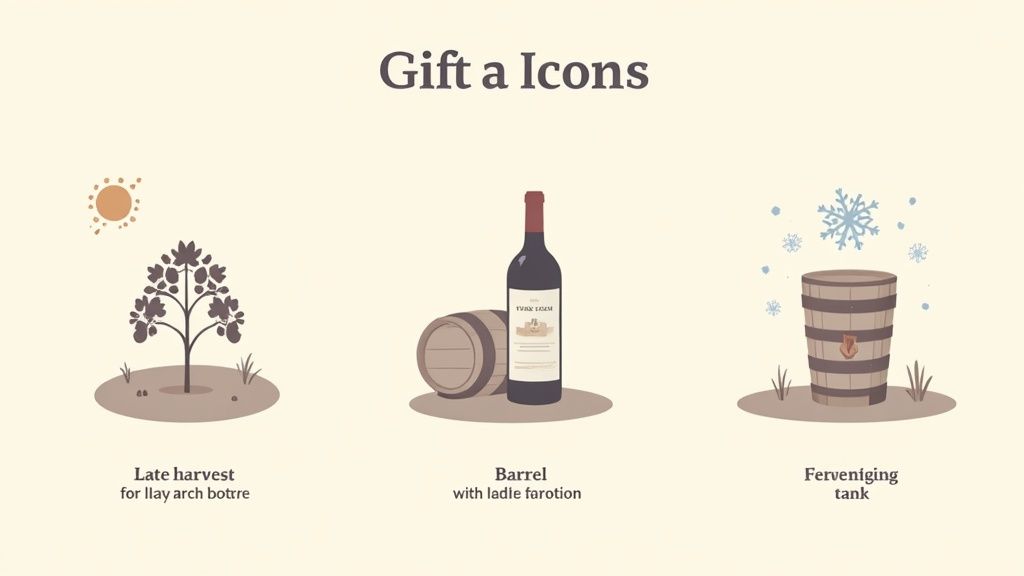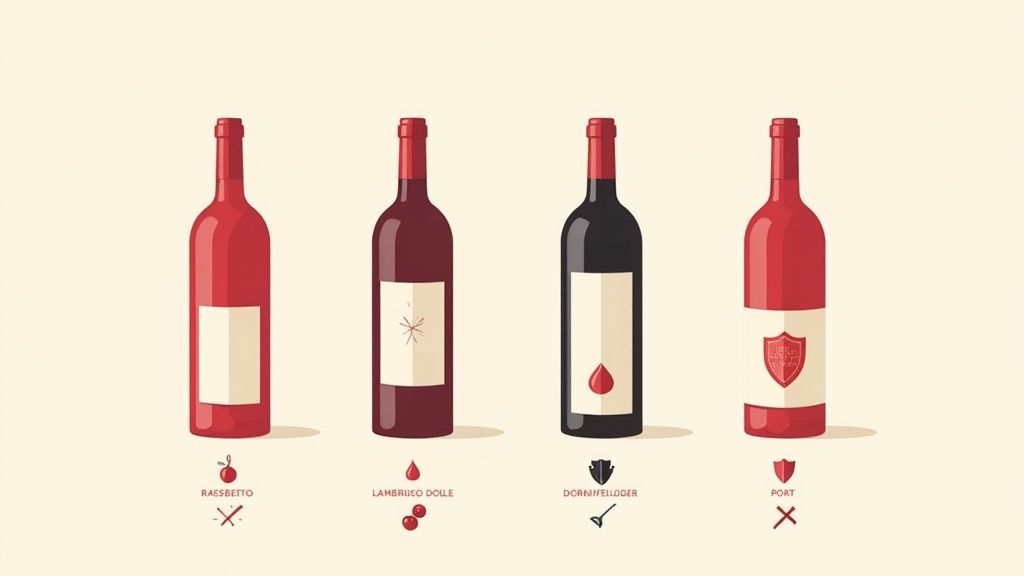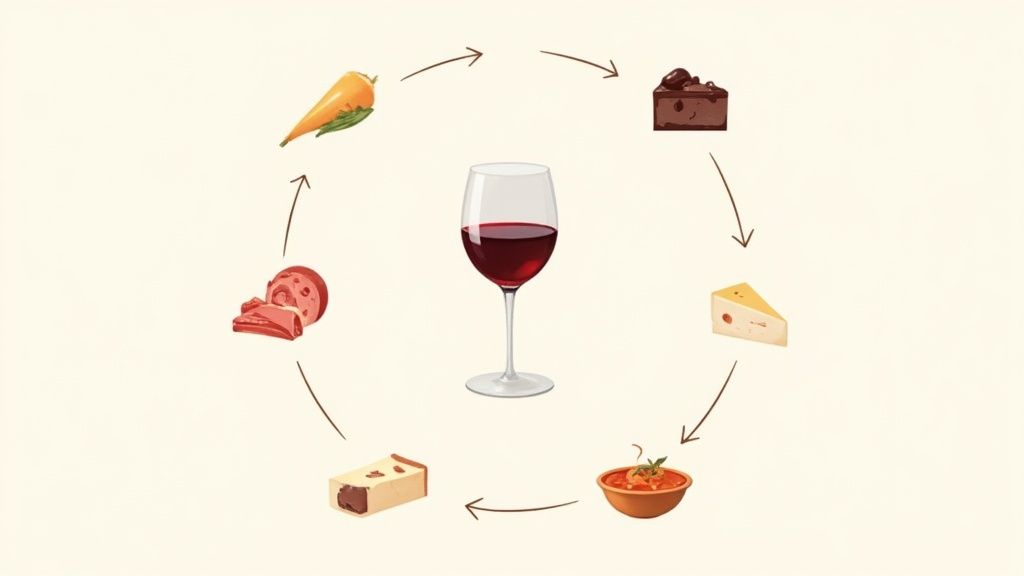When you think of red wine, what comes to mind? Probably big, bold, and dry flavours. But there’s a whole other side to the red wine world that’s often overlooked: sweet red wine varieties. These wines offer a totally different experience, full of luscious fruit notes and a smoother palate that’s perfect for newcomers or anyone looking for a delightful change of pace.
Uncorking the World of Sweet Red Wines

Let's bust a common myth right away: sweetness in red wine isn't a mistake. It’s a deliberate, and often masterful, choice by the winemaker. They achieve this profile by stopping the fermentation process just a little early, leaving some of the grapes' natural sugars what we call residual sugar in the final wine. The result? Wines that burst with ripe, almost jammy fruit flavours.
Think of this guide as your essential companion for exploring this delicious category. We're going to dive into:
- The clever winemaking tricks behind the sweetness.
- The most popular sweet red wine varieties you should know.
- Perfect food pairings that go way beyond just dessert.
- A special look at some incredible examples from Australian wine regions.
A Niche but Delicious Category
While Australia is famous globally for its powerful, dry reds, the market for sweet red styles is still a bit of a niche. The big players like Shiraz, which makes up a massive 39% of the country's vineyard plantings, and Cabernet Sauvignon are almost always made in the dry styles that drinkers around the world have come to love. You can learn more about the grape varieties that define Australian wine regions to see the full picture.
The real beauty of a sweet red wine is all about balance. A great one isn't just sugary; it harmonises that sweetness with refreshing acidity and gentle tannins. This creates a rich, satisfying tasting experience that’s complex and genuinely enjoyable.
This perfect balance is what makes these wines so incredibly versatile. They can be a gentle introduction for someone new to red wine, an exciting partner for spicy foods, or a luxurious way to cap off a memorable meal. Let's dive deeper and discover what gives these delicious wines their unique character.
How Sweet Red Wines Get Their Flavour

That captivating sweetness you find in some red wines isn't just a happy accident; it's the result of some very clever and intentional winemaking. It all starts with the natural sugars in grape juice. During fermentation, yeast gets to work, eating these sugars and turning them into alcohol. To craft a sweet wine, the winemaker simply has to hit pause on this process before all the sugar is gone.
This leftover sweetness is called residual sugar, and it’s what gives the wine its luscious, fruity character. But how exactly do they press that pause button? There are a few key methods, and each one creates a distinctly different style of sweet red wine. Getting to know these techniques is the first step to truly appreciating the craftsmanship behind this delicious category.
Late Harvest Sweetness
One of the most natural ways to achieve sweetness is through a late harvest. Winemakers will deliberately leave the grapes on the vine for weeks longer than the normal picking time. Think of it like letting a piece of fruit ripen on a tree until it's perfectly sweet and bursting with flavour.
As the grapes hang on the vine, they begin to dehydrate, which concentrates their sugars and develops deeper, more complex flavours. The resulting wines are often rich and intensely fruity, with a full-bodied texture. Because the grapes start out with so much sugar, the yeast often can't convert it all into alcohol before it naturally stops working, leaving behind that delightful sweetness.
Stopping Fermentation Early
Another common approach is to actively stop the fermentation process right in the middle of the action. It's a bit like a baker pulling a cake out of the oven at the perfect moment to keep the centre moist and gooey. Winemakers can do something similar to preserve the grape’s natural sweetness.
There are a couple of popular ways to pull this off:
- Chilling: By rapidly dropping the temperature of the fermenting wine, winemakers can send the yeast into hibernation. This makes it dormant, halting the sugar-to-alcohol conversion in its tracks. It's a popular technique for creating lighter, fresher styles of sweet reds.
- Fortification: This classic method involves adding a neutral grape spirit (like brandy) to the fermenting wine. The sudden spike in alcohol kills the yeast, instantly stopping fermentation and locking in all the remaining sugar. This technique is famous for creating robust, higher-alcohol wines like Port.
Each of these methods directly shapes the final personality of a sweet red wine. A late harvest wine might be dense and almost syrupy, while one made by chilling will feel much lighter and more delicate, showcasing just how much craft goes into every bottle.
If you're curious to learn more about the science behind it all, you can dive deeper into wine fermentation techniques in our complete guide. Once you understand how these wines are made, you'll be able to predict the style you'll enjoy just by reading the label.
Popular Sweet Red Wine Varieties to Explore

Now that we’ve pulled back the curtain on how sweet reds are made, it’s time for the fun part exploring the incredible variety out there. From the fizzy, carefree reds of Italy to the deep, complex fortified wines of Portugal, there’s a style for every palate and occasion.
Think of this as a global tasting tour from the comfort of your chair. Each wine tells a story about its home, the grapes used, and the traditions that shaped it. We’ll journey through different countries to uncover what makes each of these luscious reds tick, giving you a handy guide for your next visit to the bottle shop.
Italian Fizz and Fun
When it comes to light, refreshing, and sweet reds, Italy is the undisputed champion. These wines are often frizzante, which simply means they have a gentle sparkle. That light fizz is genius it lifts the sweetness and keeps the wine feeling vibrant and lively on the palate.
Two standouts you absolutely must try are:
- Brachetto d'Acqui: Hailing from Piedmont, this aromatic wine is like sticking your nose in a bouquet of fresh strawberries and roses. It’s incredibly fragrant, with notes of raspberry and a delicate sweetness, all wrapped up in a light, bubbly body. With a low alcohol content (usually just 5-7% ABV), it's the perfect drop for brunch or a sunny afternoon.
- Lambrusco Dolce: Lambrusco has many faces, but the 'Dolce' (sweet) version is a real crowd-pleaser. It’s bursting with juicy flavours of cherry, blackberry, and plum, all carried by a creamy fizz. It’s an incredibly food-friendly wine that proves sweet reds can be wonderfully versatile.
Rich and Robust Fortified Wines
At the complete other end of the spectrum, you'll find the fortified sweet reds. These are wines known for their power, complexity, and remarkable ability to age gracefully. You don’t gulp these down; you sip and savour them, letting their intricate layers of flavour unfold.
Fortified wines like Port are made by adding a neutral grape spirit (like brandy) during fermentation. This clever trick stops the yeast in its tracks, preserving the grape's natural sugars while boosting the alcohol to around 19-22% ABV.
The most famous example is Port, from Portugal's stunning Douro Valley. While there are several styles, Ruby Port is a fantastic starting point for sweet red lovers. It’s packed with bold flavours of blackberry, rich chocolate, and warm spice, with a full body and a long, comforting finish.
To dive deeper into these magnificent wines, check out our guide to enjoying delectable dessert wines.
Comparing Popular Sweet Red Wine Varieties
To help you keep these delicious options straight, here’s a quick-reference table. Use it to guide your next purchase based on the flavours and styles you enjoy most.
| Variety | Origin | Sweetness Level | Body | Common Flavours |
|---|---|---|---|---|
| Brachetto d'Acqui | Italy | Sweet | Light | Strawberry, Raspberry, Rose |
| Lambrusco Dolce | Italy | Sweet | Medium | Cherry, Blackberry, Plum |
| Dornfelder | Germany | Off-Dry to Sweet | Medium | Dark Cherry, Elderberry, Spice |
| Ruby Port | Portugal | Very Sweet | Full | Blackberry, Chocolate, Cinnamon |
This table gives you a snapshot of some of the world's classic sweet red styles. It's a great starting point for finding a wine that perfectly matches your mood or meal.
While Australia is famous for its powerful dry reds, a quiet revolution is bubbling away. Approximately 15% of Australia’s wine is now made from emerging, non-traditional varieties, driven by a changing climate. Grapes like Touriga Nacional (a key Port grape) are being explored right here, potentially paving the way for new and exciting Australian sweet red styles in the future. It's a thrilling time for adventurous wine lovers
Perfect Food Pairings for Sweet Red Wines

Pairing food with sweet red wine is a genuine adventure, and it goes way beyond the dessert trolley. The real secret lies in understanding how the wine's sweetness plays with different flavours on your plate.
Here's the golden rule: make sure your wine is at least as sweet as your food. If the food is sweeter, the wine can suddenly taste dull or even a bit bitter. Get that balance right, and you're in for a treat.
This simple principle is why sweet red wines are so surprisingly versatile. That touch of residual sugar can beautifully tame the heat in spicy dishes, stand up to the saltiness of cured meats, and slice right through the richness of a creamy cheese. It’s all about creating harmony, where neither the food nor the wine shouts over the other.
Savoury Pairings That Shine
Forget the old notion that sweet reds are just for the final course. Their unique character makes them a fantastic partner for a whole range of savoury dishes, setting the stage for a memorable meal from the very first bite. The trick is to think about creating a delicious push-and-pull of flavours.
Here are a few combinations that just work:
- Spicy Cuisine: The gentle sweetness in a Lambrusco Dolce or a German Dornfelder is the perfect foil for the fire in Asian or Latin American food. The wine’s fruitiness cools your palate, making every mouthful even better.
- Salty and Cured Meats: A charcuterie board loaded with prosciutto, spicy salami, and other cured goodies is a brilliant move. The salt from the meat makes the wine’s fruit notes pop, while the wine’s sweetness mellows out that salty intensity.
- Rich Cheeses: This is a classic for a reason. Bold, creamy cheeses like a tangy blue, gorgonzola, or a sharp, mature cheddar create a fantastic contrast. The wine’s sweetness cuts through the cheese’s rich, fatty texture, leaving you with a perfectly balanced mouthful.
Indulgent Dessert Pairings
Of course, sweet red wines feel right at home with dessert. This is where fortified wines, in particular, get to show off what they can do. Their depth and complexity can turn a simple sweet treat into something truly special.
A well-made fortified red, like a classic Port, is packed with concentrated notes of dark fruit, spice, and nuts. This profile makes it the perfect companion for desserts that share that same richness and intensity.
For anyone with a sweet tooth, these wines are a dream with desserts like rich dark and milk chocolate. A Vintage Port with a dense, flourless chocolate cake or a Tawny Port alongside nut-based desserts are matches made in heaven.
Australia has a long, proud history of making these styles. While fortified wines once made up over 50% of Australia’s wine exports, they're now a much smaller slice of the country's huge annual production, representing a more niche, specialist category.
Serving and Storing Sweet Red Wines Correctly
Getting the most out of your sweet red wine really comes down to one simple thing: serving it at the right temperature. It's a small detail that makes a massive difference, dramatically influencing how we perceive both sweetness and aroma. Just a few degrees can be the difference between a good glass and a great one.
Think of it like this: serving a sweet red too warm can make it taste cloying, heavy, and overly sugary. On the other hand, chill it down too much, and you risk muting all those beautiful fruit flavours and delicate aromas, leaving the wine tasting flat and lifeless. The goal is to hit that perfect sweet spot where the wine feels balanced, expressive, and utterly delicious.
The Ideal Serving Temperatures
Not all sweet reds are created equal, and they certainly don't all shine at the same temperature. Lighter, fizzier styles love a good chill, while the more complex, fortified wines prefer to be slightly warmer to let their intricate aromas unfold.
- Lightly Sweet & Sparkling Reds (6-10°C): Wines like Brachetto d'Acqui and Lambrusco Dolce are at their best when served well-chilled, much like you would a rosé or a light white wine. This temperature keeps them feeling fresh, crisp, and vibrant.
- Fruit-Forward Sweet Reds (12-14°C): For simpler, non-sparkling sweet reds like a German Dornfelder, a light chill is perfect. This lifts the bright fruit notes without hiding the wine's character.
- Fortified Sweet Reds (14-16°C): Complex and robust wines like Port are best served at a cool cellar temperature. This is just a touch below room temperature and allows their deep, nutty, and spicy aromas to really open up and show their stuff.
A quick tip for chilling your wine: for the lighter styles, 20-30 minutes in the fridge should do the trick. For those richer fortified wines, just 10-15 minutes is plenty to bring them down to the ideal temperature without overdoing it.
Storing Your Wine for Lasting Quality
Proper storage is all about protecting your investment and ensuring every bottle you open is as good as the winemaker intended. For unopened bottles, the rules are the same as for any other wine: keep them in a cool, dark place, away from wild temperature swings and direct sunlight. For a more detailed guide, check out our 7 tips for storing red wine long-term.
Once you've popped the cork, the clock starts ticking. Lighter sweet reds will last for 2-3 days in the fridge with a good stopper. Fortified wines, however, are a different story. The high sugar and alcohol act as natural preservatives, allowing them to last much longer often for several weeks or even months after opening, especially if you keep them in the fridge.
Your Questions About Sweet Red Wine, Answered
Diving into the world of sweet reds can bring up a few questions, especially when so much of the wine conversation seems to be about dry styles. Let's clear up some of the common queries and myths we hear from fellow wine lovers.
This section tackles everything from sophistication to cellar potential, giving you the confidence to explore these luscious and often misunderstood wines.
Is Sweeter Red Wine Less Sophisticated?
Not in the slightest. This is one of the most stubborn myths in wine, but the truth is, a wine's quality sweet or dry comes down to balance, complexity, and the winemaker's skill.
Think about it: some of the planet's most revered, age worthy, and expensive wines are sweet. Legendary Vintage Ports and collectible German dessert wines can fetch astonishing prices. A well crafted sweet red is a masterclass in balancing sugar against acidity, tannins, and alcohol to create something truly memorable.
The real measure of a wine's quality is its ability to deliver a balanced and unforgettable tasting experience. A truly great sweet red offers an intricate profile every bit as impressive as a top-tier dry red.
Are All Sweet Red Wines Low in Alcohol?
That's a great question, and the answer is a definite no. The alcohol content can swing wildly depending on how the wine is made, which is part of what makes this category so fascinating.
You'll find examples at both ends of the spectrum:
- Low-Alcohol Styles: Take an Italian Brachetto d'Acqui. The winemaker stops fermentation early by chilling the wine, which keeps the natural sugars high but the alcohol low, typically around 5-7% ABV.
- High-Alcohol Styles: Fortified wines like Port do the complete opposite. A neutral grape spirit is added mid-fermentation, which stops the yeast, locks in the sweetness, and jacks up the alcohol to 19-22% ABV.
So, a sweet red can be anything from light and breezy to seriously potent. Always check the label if you're curious.
Can I Age a Sweet Red Wine?
It completely depends on the style. While many sweet reds are made to be enjoyed right away, others are built to go the distance, evolving in incredible ways over decades.
Lighter, fruit-forward styles like a simple Lambrusco Dolce are at their best young, fresh, and bubbly. They won't get any better with time in the cellar, so you're best off drinking them soon after you buy them.
On the other hand, high quality fortified reds are a different beast entirely. Wines like Vintage Port or an Australian Rutherglen Muscat have everything they need for the long haul. Their high levels of sugar, tannin, and alcohol act as natural preservatives, allowing them to develop stunningly complex notes of dried fruit, nuts, and spice over many, many years.
How Can I Tell If a Red Wine Is Sweet?
Your best tool is right there on the bottle: the label. Winemakers usually leave plenty of clues to guide you.
Keep an eye out for specific keywords. An Italian wine might say 'Dolce' (sweet) or 'Amabile' (off-dry). German labels often use 'lieblich' (sweet) or 'süß' (very sweet). These are clear signposts.
The style name itself is often a dead giveaway for fortified wines like 'Port', 'Tawny', or 'Muscat'. If you want to get technical, the back label might list the 'Residual Sugar' (RS), measured in grams per litre (g/L). As a rule of thumb, anything over 30 g/L will taste noticeably sweet.
At McLaren Vale Cellars, we celebrate the entire spectrum of wine styles, from the boldest dry reds to the most elegant sweet and fortified wines. Our curated selection showcases the incredible diversity and quality of South Australia’s premier wine region. Explore our collection and discover your next favourite bottle today. https://www.mclarenvalecellars.com




Comments (0)
There are no comments for this article. Be the first one to leave a message!